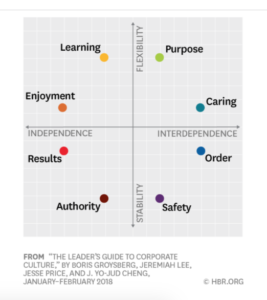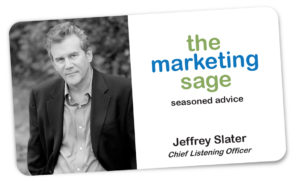When I first heard the expression, culture eats strategy for breakfast from Peter Drucker, it helped explain the root cause of strategic failures I have witnessed during my marketing and entreprenurial career.
Companies that fail might have had brilliant strategies and pristine-clear approaches to marketing, but they were unable to gain traction. The human factor determines whether a great idea gets executed.
This issue of culture isn’t about beers in an office fridge and pool tables at work. It is about how people are treated and if they feel motivated to make things happen. The type of culture your business has will dictate if people are rigorous about tracking their work, holding each other accountable and motivated to go the extra mile.
What’s Culture?
Organizational culture encompasses values and behaviors that contribute to the unique social and psychological environment of a business. Dr. Elliott Jaques first introduced the concept of culture in the organizational context in his book The Changing Culture of a Factory in 1951.
Do employees understand the vision of the business? Are they passionate and engaged in the work? Often the founders and leaders set the tone for the culture through actions, rarely through their words.
I will always remember when I returned from work after my father’s passing, my boss Lars, came by my office and sat with me for an hour.
He wanted to know about my dad. I was so moved by his empathy for me, that I would have run through a wall for him to get the job done. A culture of caring started at the top and spread throughout the company.
Corporate culture is ever-changing. The leaders and their management style shape the culture. If a leader holds her Executive Team accountable weekly for what they said they’ll do, that trickles down to staff meetings in departments. If that same CEO is lackadaisical, that sets a tone for how others will behave.
Strategy defines the direction and frames the plan. But culture is like the lubricant that makes the gears turn.
Culture Factor
I read a terrific article in HBR this past week called. The Leaders Guide to Corporate Culture. They define 8 types of culture.
This reminds me of brand archetype work, except for companies. A company might have a fusion of two types of cultures like purposeful and learning. The important point in the article is that when there is spatial distance between a company’s culture it means tradeoffs in other areas.
The spatial relationships are important.
Proximate styles, such as safety and order or learning and enjoyment, will coexist more easily than styles that are far apart on the chart, such as authority and purpose, or safety and learning.
Achieving a culture of authority often means gaining the advantages (and living with the disadvantages) of that culture but missing out on the advantages (and avoiding the disadvantages) of a culture of purpose.
 The following chart and excerpt are from The Harvard Business Review Article. All rights reserved. These 8 types of culture are explained and use a well-known company for illustration purposes. The 2 X 2 box shos stability – flexibility and independence and interdependence.
The following chart and excerpt are from The Harvard Business Review Article. All rights reserved. These 8 types of culture are explained and use a well-known company for illustration purposes. The 2 X 2 box shos stability – flexibility and independence and interdependence.
Learning: Tesla
“I’m interested in things that change the world or that affect the future and wondrous new technology where you see it and you’re like ‘Wow, how did that even happen?’”
—Elon Musk, cofounder and CEO
Learning is characterized by exploration, expansiveness, and creativity. Work environments are inventive and open-minded places where people spark new ideas and explore alternatives. Employees are united by curiosity; leaders emphasize innovation, knowledge, and adventure.
Purpose: Whole Foods
“Most of the greatest companies in the world also have great purposes….Having a deeper, more transcendent purpose is highly energizing for all of the various interdependent stakeholders.”
—John Mackey, founder and CEO
Purpose is exemplified by idealism and altruism. Work environments are tolerant, compassionate places where people try to do good for the long-term future of the world. Employees are united by a focus on sustainability and global communities; leaders emphasize shared ideals and contributing to a greater cause.
Caring: Disney
“It is incredibly important to be open and accessible and treat people fairly and look them in the eye and tell them what is on your mind.”
—Bob Iger, CEO
Caring focuses on relationships and mutual trust. Work environments are warm, collaborative, and welcoming places where people help and support one another. Employees are united by loyalty; leaders emphasize sincerity, teamwork, and positive relationships.
Authority: Huawei
“We have a ‘wolf’ spirit in our company. In the battle with lions, wolves have terrifying abilities. With a strong desire to win and no fear of losing, they stick to the goal firmly, making the lions exhausted in every possible way.”
—Ren Zhengfei, CEO
Authority is defined by strength, decisiveness, and boldness. Work environments are competitive places where people strive to gain personal advantage. Employees are united by strong control; leaders emphasize confidence and dominance.
Results: GSK
“I’ve tried to keep us focused on a very clear strategy of modernizing ourselves.”
—Sir Andrew Witty, former CEO
Results is characterized by achievement and winning. Work environments are outcome-oriented and merit-based places where people aspire to achieve top performance. Employees are united by a drive for capability and success; leaders emphasize goal accomplishment.
Enjoyment: Zappos
“Have fun. The game is a lot more enjoyable when you’re trying to do more than make money.”
—Tony Hsieh, CEO
Enjoyment is expressed through fun and excitement. Work environments are lighthearted places where people tend to do what makes them happy. Employees are united by playfulness and stimulation; leaders emphasize spontaneity and a sense of humor.
Order: SEC
“Rule making is a key function of the commission. And when we are setting the rules for the securities markets, there are many rules we, the SEC, must follow.”
—Jay Clayton, chairman
Order is focused on respect, structure, and shared norms. Work environments are methodical places where people tend to play by the rules and want to fit in. Employees are united by cooperation; leaders emphasize shared procedures and time-honored customs.
Safety: Lloyd’s of London
“To protect themselves, businesses should spend time understanding what specific threats they may be exposed to and speak to experts who can help.”
—Inga Beale, CEO
Safety is defined by planning, caution, and preparedness. Work environments are predictable places where people are risk-conscious and think things through carefully. Employees are united by a desire to feel protected and anticipate change; leaders emphasize being realistic and planning ahead.
What are you eating for breakfast?
Need help to evaluate culture and strategy issues?
I can help. You can set up a time chat with me about your marketing challenges using my calendar. Our initial conversation is free. You talk, I listen. Email me jeffslater@themarketingsage.com or call me. 919 720 0995. Visit my website at www.themarketingsage.com. Let’s explore working together today.

Photo by Ben Kolde on Unsplash
Chart image and descriptions from HBR. All rights reserved




